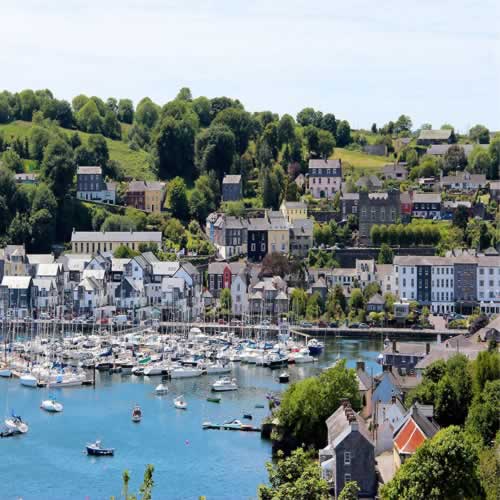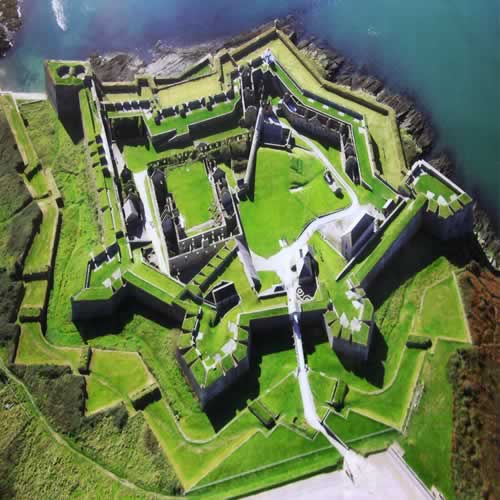KINSALE - NEIGHBORHOODS



Kinsale
Kinsale (pop. 5,281) is a historic port located at the mouth of the River Bandon, located approximately 15 miles south-southwest of Cork City. Kinsale was founded in the fourteenth century, and in Irish the name of the town means `the tide head`, referencing the Old Head of Kinsale, a sandstone-and-shale headland which juts out three miles from the mainland south of Kinsale proper. Its growth as a regional fishing and trading hub was noticed by not only the ruling English, but also the Spanish, which first made contact with the people of Kinsale in the year 1518.
The Spanish armada of 1601 attempted to send ground troops to Kinsale, in the hope that their involvement would turn the tide in favor of the Irish alliance, which was fighting a bitter battle against the English colonizers. Although 4,000 Spanish troops landed in Kinsale, it was not enough, and the 1601 Battle of Kinsale is looked at as the last hurrah for the Irish insurgents who had hoped to spurn the English. The Irish revolutionary tradition would not be extinguished for good in Kinsale; Michael Collins, one of the revolutionaries which helped Ireland gain its independence from England in the 1920s, had ties to Kinsale and to many of the towns to the south and southwest.
The town`s military past is evidenced most strongly by the seventeenth-century star fortress Charles Fort, located across the River Bandon estuary from James Fort, the original fortification serving Kinsale during the Siege of 1601. Kinsale is also known as being the site of investigation and inquest following the May 7, 1915 sinking of the RMS Lusitania, a passenger liner shot by a German submarine. There is a Lusitania museum located inside the Old Head Signal Tower, and another Lusitania museum exhibition hosted by the Kinsale Museum.
The most-trafficked area of Kinsale is the Harbor, with a road running parallel called Lower Road on the west side of the Harbor and Scilly Walk on the east side, leading to Charles Fort. On the southern side of the Harbor monuments runs Lower O`Connell Street, which runs one-way from Upper O`Connell and Main Streets to the north. Kinsale is known today for its gourmet food scene, and you can find a lot of these delicious farm-to-table local cafes and restaurants along Market Street, Market Lane and in Market Square. The Kinsale Museum is also close by. The Saint Multose Church of Ireland is located west of Higher O`Connell Street, and the St. John the Baptist Roman Catholic Church is located on Friars Street.

Innishannon and Bandon
Innishannon is the first town you will see when traveling west on the N71 road from Kinsale. A small town of just 900 people, Innishannon is a beautiful introduction to the western road which traverses the southern coastal areas directly from Cork. Experience this quiet and quaint town for a few hours before continuing west, in particular the beautiful religious architecture, like the buildings of the local Catholic Church and the Church of Ireland.
Split between two hills overlooking the River Bandon, the town of Bandon (pop. 6,900) has a place in Irish military history alongside Kinsale, as it was a noted fortified settlement protecting Cork to the east. It was also the closest town to Beal na Blath, six miles away, where Irish revolutionary Michael Collins was assassinated in 1922. Bandon is well-known for its music festival each June and for the cultural heritage festival called the `Walled Town Festival` which is held every August.


Clonakilty and Rosscarbery
The next major town you will stop at, along the N71, after Bandon is Clonakilty (pop. 4,500), considered a tourist hub for the western part of County Cork. The seaside town, sitting on Clonakilty Bay, is known for its bed and breakfasts and resorts which line the waterfront. Points of interest include the West Cork Model Railway Village, a miniature version of a typical County Cork Village, located on a train line; and the Michael Collins House, a museum which tells the story of revolutionary Michael Collins and his role in securing Irish independence (Michael Collins lived in this house between 1903 and 1905).
With a year-round population of just 490, you may not know that Rosscarbery positively blooms with activity during the spring and summer months. It is a popular destination for vacationers who want to stop along the way while exploring either the Cork-Bandon road or the beginnings of the Wild Atlantic Way. There are two stone circles adjacent to town: Drombeg, to the west, and Bohonagh, to the east. Owenahincha Beach, to the southeast of town, is considered a `celebrity beach` due to the number of star sightings one can see in the summertime. Northwest of town is the fifteenth-century fortified Castle Salem, now run as a guest house.



Castletownshend, Skibbereen, and Baltimore
As you drive toward Skibbereen from Rosscarbery, head west off the N71 for a little while and visit the village of Castletownshend, situated on a cliff overlooking Castlehaven Harbor. The town was named after Richard Townsend, a seventeenth century soldier and politician who retired here and built a small castle here, around where the Church of St. Barrahane is located today. The beautiful Gothic Revival stained glass windows were commissioned by Powell`s of London in the early 19th century. Castletownshend is renowned for its first-rate kayaking and whale watching tours.
The tiny and picturesque town of Skibbereen (pop. 2,700), located on the River Ilen, is known today as a vibrant arts and crafts center, with the West Cork Arts Centre headquartered here. It is also a noteworthy foodie destination, known for its farm-to-table artisan dishes and a nice complement to the great food you already experienced while eating in Kinsale. In Irish history, Skibbereen is well-known for being one of the towns most affected by the Great Famine of the mid-nineteenth century; it is estimated that nearly 10,000 people died in a seven-year span in the 1840s.
One of the southernmost villages on the Irish coast, Baltimore (pop. 323) is the main ferry port for those wishing to explore Cape Clear Island and Sherkin Island to the south. Baltimore is named Dun Na Sead in Gaelic, the fort of the jewels, and that fort is a castle which overlooks the harbor. In ancient times, Baltimore was considered a sanctuary town for the druids. The former Kings of Tara and Kings of Munster made their home here, well before the English colonized the town in the early 1600s. In 1631, Barbary pirates sacked Baltimore and for over a century afterward, the town was completely depopulated. The town`s most famous landmark is perhaps the Baltimore Beacon, a lighthouse built out of white stone and locally referred to as `Lot`s wife`, as it resembles a pillar of salt.